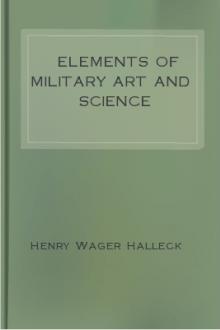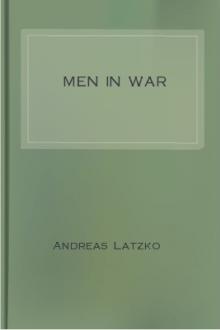Elements of Military Art and Science by Henry Wager Halleck (books you have to read txt) 📕

- Author: Henry Wager Halleck
- Performer: -
Book online «Elements of Military Art and Science by Henry Wager Halleck (books you have to read txt) 📕». Author Henry Wager Halleck
"These instructions issue from the dictates of plain nature, and do not require the least elucidation in writing They constitute the A, B, C of soldiers. Nothing can be more simple, or more intelligible; so much so, that it would be ridiculous in a general to sacrifice essential objects in order to attend to such minutiæ. His functions in the day of battle are confined to those occupations of the mind, by which he is enabled to watch the countenance of the enemy; to observe his movements, and to see with an eagle's or a king of Prussia's eye, all the relative directions that his opponents take. It must be his business to create alarms and suspicions among the enemy's line in one quarter, while his real intention is to act against another; to puzzle and disconcert him in his plans; to take advantage of the manifold openings which his feints have produced, and when the contest is brought to issue, to be capable of plunging with effect upon the weakest part, and carrying the sword of death where its blow is certain of being mortal. But to accomplish these important and indispensable points, his judgment must be clear, his mind collected, his heart firm, and his eyes incapable of being diverted, even for a moment, by the trifling occurrences of the day."
The administrative service of an army is usually divided into several distinct departments, as—
It was intended to enter into the history, organization, and use of each of these civico-military departments of an army; but our limits are such as to preclude any thing like so detailed a discussion as would be necessary for a proper understanding of the subject. We therefore pass from the staff directly to the line or rather the four principal arms of an army organization.[30]
[30]
Of works that treat directly of staff organization and duties, those of Grimoard, Thiébault, Boutourlin, Labaume, are esteemed among the best. The writings of Jomini, Napoleon, Rocquancourt, Vauchelle, Odier, Scharnhorst, also contain much valuable information on this subject. The following list of books may be referred to for further information on the subjects alluded to in this chapter:
Aide-Mémoire des officiers généraux et supérieurs et des capitaines.
Précis de l'art de la guerre. Jomini.
Mémoires de Napoléon. Montholon et Gourgaud.
Cours élémentaire d'art et d'histoire militaires. Rocquancourt.
Cours élémentaire d'administration militaire. Vauchelle.
Droite élémentaire d'art militaire, &c. Gay de Vernon.
Annuaire militaire historique, &c. Sicard.
Cours abrégé d'administration militaire. Bernier.
Cours d'administration militaire, &c. Odier.
De l'administration de l'armée d'Espagne. Odier.
De l'organization de la force armée en France. Carion-Nisas.
Elémens de l'art militaire, &c. Cugnot.
Mémoires sur la guerre. Feuquiéres.
Cours d'art militaire et d'histoire. Jacquinot de Presle.
Cours d'art militaire. Fallot.
Théorie de l'officier supérieur. Léorier.
Histoire de l'administration de la guerre. Audouin.
Instructions diverses a l'usage de l'école d'application du corps royal d'état-major.
Handbuch für offiziere, &c. Scharnhorst.
Having omitted all discussion of the several departments of the administrative service of an army organization, it is not deemed necessary to give the names of books of reference on the subjects of pay, courts-martial, medicinal and hospital departments, &c., &c.
CHAPTER XARMY ORGANIZATION.[31]—INFANTRY AND CAVALRY
Infantry.—Infantry constitutes, in active service, by far the most numerous portion of an army; in time of peace its duties are simple, and, in most countries, of little comparative importance; but in our country the continually recurring difficulties on the Indian frontiers, render this arm peculiarly necessary and important, even in time of general peace. From the nature of infantry service—no peculiar technical knowledge (we speak of the privates and officers of the lower grades) being so absolutely indispensable as in the other arms—the soldier may in a short time be trained and instructed in his duties. For this reason the ratio of infantry in a peace establishment is ordinarily much less than in active service, this arm being always capable of great expansion when occasion requires.
[31]
In discussing our own organization, it may be well to compare it with the armies of some of the principal nations of Europe. Our limits will not allow us to go very much into details, nor to make a comparison with more than a single European power. We shall select France, inasmuch as her army organization has served as a model for the rest of Europe, and is still, in some respects, superior to most others.
In the early periods of society, and in countries where horses abounded, men have usually preferred fighting on horseback; but civilization and a more thorough acquaintance with war has always increased the importance of infantry.
The Hebrews, and also the Egyptians, employed this arm almost exclusively. The Asiatics generally employed both infantry and cavalry, but with the Greeks the infantry was the favorite arm. Even their kings and generals usually fought on foot. The Romans conquered the world mainly with their infantry. This arm was also considered of the greatest importance by the ancient Germans and Gauls; but the migration of the Huns and other Mongolic tribes mounted on small and fleet horses, and the acquaintance formed by the Franks of northern Spain with the Moors, who were mounted on beautiful horses from Arabia and the plateau of Asia, introduced a taste for cavalry in western Europe. This taste was still further cultivated under the feudal system, for the knights preferred fighting on horseback to serving on foot. During the crusades the infantry fell into disrepute. But the invention of gunpowder changed the whole system of warfare, and restored to infantry its former importance.
"The Romans," says Napoleon in his Memoirs, "had two infantries; the first, lightly armed, was provided with a missile weapon; the second, heavily armed, bore a short sword. After the invention of powder two species of infantry were still continued: the arquebusiers, who were lightly armed, and intended to observe and harass the enemy; and the pikemen, who supplied the place of the heavy-armed infantry. During the hundred and fifty years which have elapsed since Vauban banished lances and pikes from all the infantry of Europe, substituting for them the firelock and bayonet, all the infantry has been lightly armed...... There has been since that time, properly speaking, only one kind of infantry: if there was a company of chasseurs in every battalion, it was by way of counterpoise to the company of grenadiers; the battalion being composed of nine companies, one picked company did not appear sufficient. If the Emperor Napoleon created companies of voltigeurs armed like dragoons, it was to substitute them for those companies of chasseurs. He composed them of men under five feet in height, in order to bring into use that class of the conscription which measured from four feet ten inches to five feet; and having been until that time exempt, made the burden of conscription fall more heavily on the other classes. This arrangement served to reward a great number of old soldiers, who, being under five feet in height, could not enter into the companies of grenadiers, who on account of their bravery, deserved to enter into a picked company: it was a powerful incentive to emulation to bring the giants and pigmies into competition. Had there been men of different colors in the armies of the emperor, he would have composed companies of blacks and companies of whites: in a country where there were cyclops or hunchbacks, a good use might be made of companies of cyclops, and others of hunchbacks."
"In 1789, the French army as composed of regiments of the line and battalions of chasseurs; the chasseurs of the Cevennes, the Vivarais, the Alps, of Corsica, and the Pyrenees, who at the Revolution formed half brigades of light infantry; but the object was not to have two different sorts of infantry, for they were raised alike, instructed alike, drilled alike; only the battalions of chasseurs were recruited by the men of the mountainous districts, or by the sons of the garde-chasse; whence they were more fit to be employed on the frontiers of the Alps and Pyrenees; and when they were in the armies of the North, they were always detached, in preference, for climbing heights or scouring a forest; when these men were placed in line, in a battle, they served very well as a battalion of the line, because they had received the same instructions, and were armed and disciplined in the same manner. Every power occasionally raises, in war-time, irregular corps, under the title of free or legionary battalions, consisting of foreign deserters, or formed of individuals of a particular party or faction; but that does not constitute two sorts of infantry. There is and can be but one. If the apes of antiquity must needs imitate the Romans, it is not light-armed troops that they ought to introduce, but heavy-armed soldiers, or battalions armed with swords; for all the infantry of Europe serve at times as light troops."
Most European nations, for reasons probably similar to those of Napoleon, keep up this nominal division of infantry of the line and light infantry; but both are usually armed and equipped alike, and both receive the same organization and instruction. The light infantry are usually made up from the class of men, or district of country, which furnishes the greatest number of riflemen and sharpshooters. In France, the light infantry is best supplied by the hunters of the Ardennes, the Vosges, and the Jura districts; in Austria, by the Croates and Tyrolese; in Prussia, by the "försters," or woodsmen; and in Russia, by the Cossacks. Our own western hunters, with proper discipline, make the best tirailleurs in the world.
Light infantry is usually employed to protect the flanks of the main army, to secure outposts, to reconnoitre the ground, secure avenues of approach, deceive the enemy by demonstrations, and secure the repose of the other troops by patrolling parties. They usually begin a battle, and afterwards take their places in the line, either on the flanks, or in the intervals between the larger bodies. The battle of Jena furnishes a good example of the use of French light infantry; and at the battle of Waterloo, the Prussian tirailleurs were exceedingly effective in clearing the ground for the advance of Blücher's heavy columns. The attack of Floh-hug by Augereau, of Vierzehn Heilegen by Suchet, of Iserstaedt by Desjardins, are models well worthy of study.
The infantry of the line acts in masses, and, on the field of battle, constitutes the principal fighting force. Its formations and the manner of engaging it have already been discussed under the head of tactics.
The importance of infantry is due, in considerable part, to the fact that it can be used everywhere—in mountains or on plains, in woody or open countries, in cities or in fields, on rivers or at sea, in the redoubt or in the attack of the breach; the infantry depends only on itself, whereas the other arms must depend in a considerable degree on the efficiency of their materials and the will and strength of brute force; and when the snows of Russia or the deserts of Egypt deprive their animals of the means of sustenance, they become perfectly useless.
Foot-soldiers, in olden times, were armed with a spear and sometimes with a sword, arrows, lance, and sling. At present they are armed with a gun and





Comments (0)